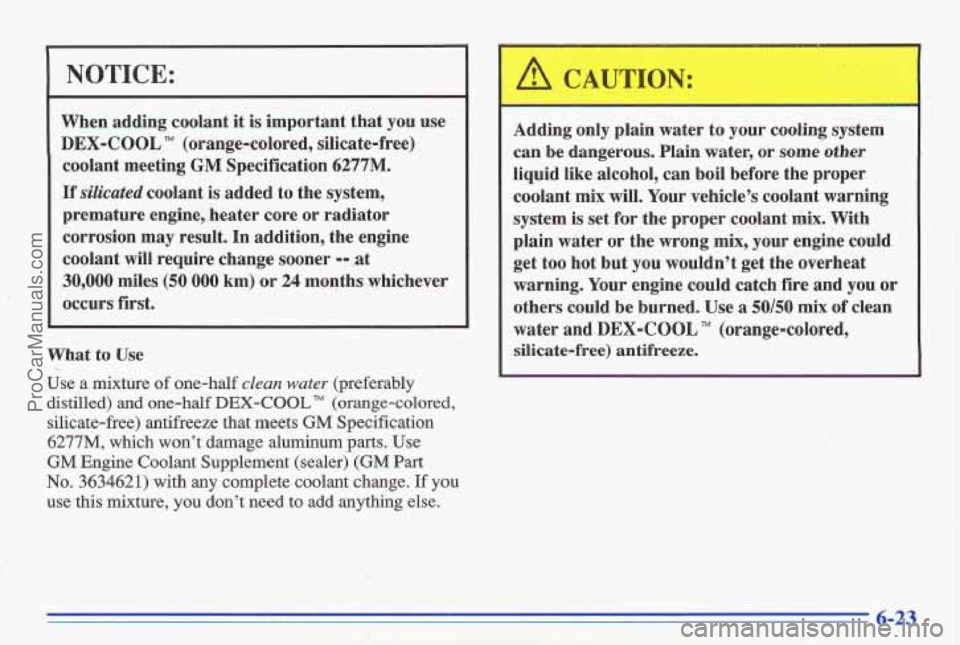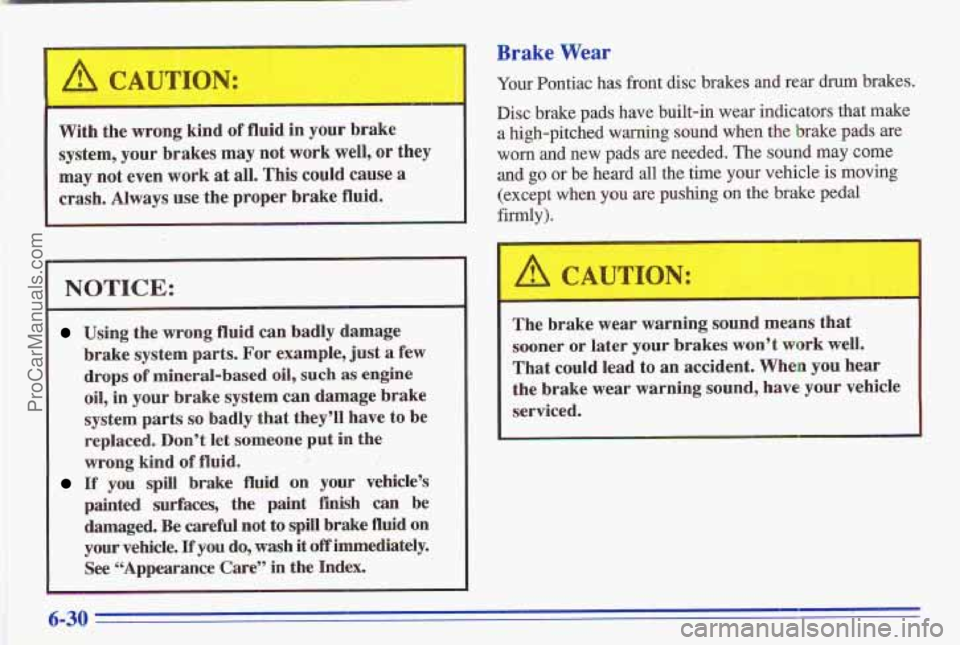Page 245 of 356

NOTICE:
When adding coolant it is important that you use
DEX-COOL TM (orange-colored, silicate-free)
coolant meeting
GM Specification 6277M.
If silicated coolant is added to the system,
premature engine, heater core or radiator
corrosion may result. In addition, the engine
coolant will require change sooner --,at
30,000 miles
(50 000 km)'or 24 months whichever
occurs first.
What to Use
Use a mixture of one-half clean water (preferably
distilled) and one-half
DEX-COOL TM (orange-colored,
silicate-free) antifreeze that meets GM Specification
6277M, which won't damage aluminum parts. Use
GM Engine Coolant Supplement (sealer) (GM Part
No. 3634621) with any complete coolant change. If you
use this mixture, you don't need to add anything else.
.
Adding only plain water to your cooling system
can be dangerous. Plain water,
or some other
liquid like alcohol, can bo'il before the proper
coolant mix will. Your vehicle's coolant warning'
system is set for the proper coolant mix. With
plain water or the wrong mix, your engine could
get too hot but you wouldn't get the overheat
warning. Your engine could catch
fire and you or
others could be burned. Use a 5060 mix of clean
water and
DEX-COOL (orange-colored,
silicate-free) antifreeze.
f' . ..
ProCarManuals.com
Page 246 of 356
NOTICE:
If you use an improper coolant mix, your engine
could overheat and be badly damaged. The
repair cost wouldn’t be covered by your
warranty. Too much water
in the mix can freeze
and crack the engine, radiator, heater core and
other parts.
If you have to add cooldnt more than four times a year,
have
your dealer check your cooling system,
I NOTICE:
If you use the proper coolant, you don’t have to
add extra inhibitors or additives which claim to
improve the system. These can be harmful.
Checking Coolant
The coolant surge tank is located on the passenger side
of the engine compartment.
0
ProCarManuals.com
Page 247 of 356
A CAUTION:
Turning the surge tank pressure cap when the
engine and radiator are hot can allow steam and
scalding liquids to blow out and burn you badly.
Never turn the surge tank pressure cap
-- even a
little -- when the engine and radiator are hot.
When your engine is cold, the coolant level should be at
the FULL
COLD mark, or a little higher.
If this light comes on,
means you’re low on engine
coolant.
See “LOW coolant Warning
Light” in the Index.
Adding Coolant
If you need more coolant, add the proper mix at the
surge tank, but only when the engine is cool.
I A CAUTION:
You can be burned if you spill coolant on hot
engine parts. Coolant contains ethylene glycol,
and it will burn if the engine parts are .hot
enough. Don’t spill coolant on
a hot engine.
~~
When replacing the pressure cap, make sure it is tight.
ProCarManuals.com
Page 248 of 356
Surge Tank Pressure Cap
NOTICE: ~~ ~
Your pressure cap is an 15 psi l(105 kPa)
pressure-type cap and must be tightly installed to
prevent coolant loss and possible engine damage
from overheating,
When you replace your surge tank pressure cap, a GM
cap is recommended.
Thermostat
Engine coolant temperature is controlled by a thermostat
in the engine coolant system, The thermostat stops the
flow of coolant through the radiator until the coolant
reaches
a preset temperature.
When you replace your thermostat,
an AC@ thermostat
is recommended.
Power Steering Fluid
When to Check Power Steering Fluid
It is not necessary to regularly check power steering
fluid unless
you suspect there is a leak in the system or
you hear an unusual noise. A fluid loss in this system
could indicate a problem. Have the system inspected
and
repaired.
6-26
ProCarManuals.com
Page 252 of 356

With the wrong kind,of fluid in your brake
system, your brakes
may not work well, or they
may not even work
at all, This could cause a
crash. Always use the moper brake fluid.
NOTICE:
Using the wrong fluid can badly damage
brake system park.
For example, just a few
drops
of mineral-based oil, such as engine
oil, in your brake system can damage brake
system
parts so badly that they’ll have to be
replaced. Don’t
let someone put in the
wrong kind of fluid.
If you spill brake fluid on your vehicle’s
painted surfaces, the paint
finish can be
damaged. Be careful not to spill brake fluid on
your vehicle, If you do, wash it off immediately.
See “Appearance Care” in
the Index.
i ‘I I .- ’;/
Brake Wear
Your Pontiac has front disc brakes and sear drum brakes.
Disc brake pads have built-in wear indicators that make
a high-pitched warning sound whew the brake pads are
worn and new pads are needed. The sound may come
and go or be heard all the time your vehicle is moving
(ex’cept when
you are pushing on.the brake pedal
firmly).
The brake wear warning sound means that
sooner
or later your brakes wonY work well.
That could lead
to an accident. When you hear
the brake wear warning sound, have your vehicle
serviced.
6-30
ProCarManuals.com
Page 275 of 356
Vehicle Identification Number (VIN)
SAMPLE4UXTM072675 bl
ENGINEAG f ASSEMBLY
CODE MODEL YEAR PLANT
This is the legal identifier for your Pontiac. It appears on
a plate in the front corner of the instrument panel, on‘the
driver’s side.
You can see it if you look through the
windshield from outside your vehicle. The
VIN also
appears on the Vehicle Certification and Service Parts
labels and the certificates of title and registration.
Engine Identification
The eighth character in your VIN is the engine code.
This code
will help you identify your engine,
specifications,
and replacement parts.
Service Parts Identification Label
You’ll find this label on your spare tire cover. It’s very
helpful if you ever need to order parts. On this label is:
your VIN,
the model designation,
paint information, and
a list of all production options and special
Be sure that this label is not removed from the vehicle. equipment.
6-53
ProCarManuals.com
Page 277 of 356

Fuses and Circuit Breakers
The wiring circuits in your vehicle are protected from short circuits by
a combination of fuses, circuit breakers
and fusible links. This greatly reduces the chance of
damage caused by electrical problems.
Look at the silver-colored band inside the fuse.
If the
band is broken or melted, replace the fuse. Be sure to
replace a bad fuse with
a new one of the identical size
and rating.
If
you ever have a problem on the road and don’t have a
spare fuse, you can borrow one that has the same
amperage. Just pick a feature of your vehicle that you
can get along without
-- like the radio or cigarette
lighter -- and use its fuse, if it is the correct amperage.
Replace it as soon as you can.
There are two fuse blocks in
your vehicle: the
instrument panel fuse block and the engine compartment
fuse block.
Instrument Panel Fuse Block
The main fuse panel is located on the left side of the
instrument panel. To access the fuses, open the fuse
panel door.
6-55
ProCarManuals.com
Page 280 of 356
Engine Compartment Fuse Block Fuse
F/P INJ
ERLS
ABs/Evo
IGN MOD
HVAC
BLO MOT
PCM BATT
CLG FAN
HDLP
STOP LPS
PWR ACC
RR DEFG
ABS
Usage
Fuel Pump: Fuel Injectors
Back-up
Lamps: Canister Purge Valve,
EGR: Automatic Transmission,
Brake Transmission Shift Interlock,
Anti-lock Brakes: Variable
Effort
Steering, Air Conditioning
Compressor,
Park Lock Solenoid
Anti-Lock Brake Solenoids,
Variable Effort Steering
Ignition System
Heater/Ais Conditioner-High Blower, Generator-Voltage Sense
Powertrain Computer
Engine Cooling Fan
Lighting Circuits
Power Accessories,
Stop Lamp Circuits,
Rear Window Defogger
Anti-Lock Brakes,
Variable
Effort Steering
Ignition Switched Circuits
I , ^*^ >, .. ,.",
The engine compartment fuse block is located on the
driver's side
of the engine compartment, near the battery,
€GN sw
ProCarManuals.com